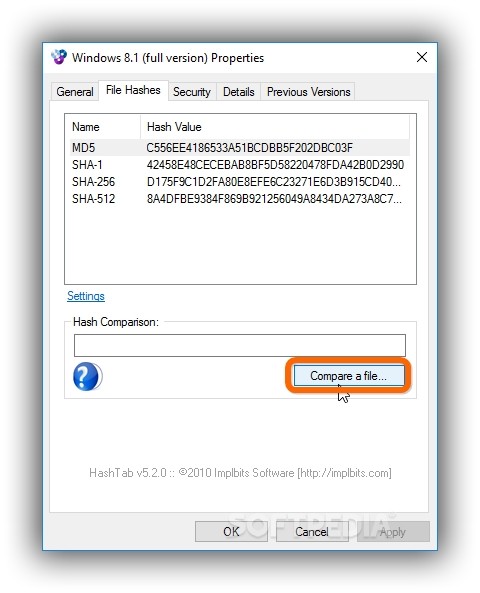

- #FILE CHECKSUM INTEGRITY VERIFIER HOW TO#
- #FILE CHECKSUM INTEGRITY VERIFIER INSTALL#
- #FILE CHECKSUM INTEGRITY VERIFIER FREE#

On a Web server, for instance, it would be important to know if any. exe, which are the most likely to be tampered with.(However, if you have time, it makes sense to create a hash for every file. To speed up this command, you could calculate hashes only for program file types. FCIV also works as a command-line checksum tool, and the following command will calculate and store the hash value for every file in the systemroot - the folder where the operating system files are located - and store them in an XML file called windowsystemhashes.XML located in the C drive:įciv.exe -add %systemroot% -r -XML c:\windowsystemhashes.XML FCIV can also recursively generate hash values for all the files in a folder and its subfolders so you could create hash values for your entire C drive with the command:Ī more useful exercise, however, would be to calculate a checksum for each system file and store them in an XML file database so you can see if any of them have been changed at a later date. In order to generate a hash value for a file that you're going to post to your own website for users to download, you would simply use the same commands. To display the SHA-1 hash of the file you would change the command to: To calculate the MD5 hash for any downloaded file, all that's required is to open a command prompt* at the folder containing your downloaded file and type the following:
#FILE CHECKSUM INTEGRITY VERIFIER INSTALL#
The install program asks where you would like to install FCIV, and I recommend the Windows\System32 folder so you can call FCIV from any folder without having to type the full path to access it each time you want to run the command.
#FILE CHECKSUM INTEGRITY VERIFIER HOW TO#
The Microsoft FCIV install program contains two files, fciv.exe and ReadMe.txt - the latter contains information and instructions on how to use FCIV. In this tip, we'll take a closer look at this tool. It can also perform various other useful tasks.
#FILE CHECKSUM INTEGRITY VERIFIER FREE#
Although, as mentioned above, MD5 is considered cryptographically broken, it would be nigh on impossible for someone to alter the file to make it malicious and end up with the same MD5 checksum, meaning this type of validation effort is still a useful exercise.īut how do you calculate the MD5 hash value of a file you've downloaded when you're running a Windows-based PC? Microsoft provides a free but unsupported command-line utility called File Checksum Integrity Verifier (FCIV) that computes MD5 or SHA-1 cryptographic hashes for files.

By calculating the MD5 hash of a downloaded file and comparing it to the MD5 hash provided by the website, it's possible to establish the file's integrity and validate that the file has arrived intact and is the file posted by the site, and not one that has been tampered with by a hacker. While MD5 is no longer considered cryptographically secure and is being replaced by the SHA-2 family of hash functions, it is nevertheless still widely used to provide a hash value for files that are downloaded from the Internet, phpMyAdmin and MySQL being just a couple of examples. UK company launches tool to monitor other Microsoft security tools: MBSA and MSAT explained.


 0 kommentar(er)
0 kommentar(er)
